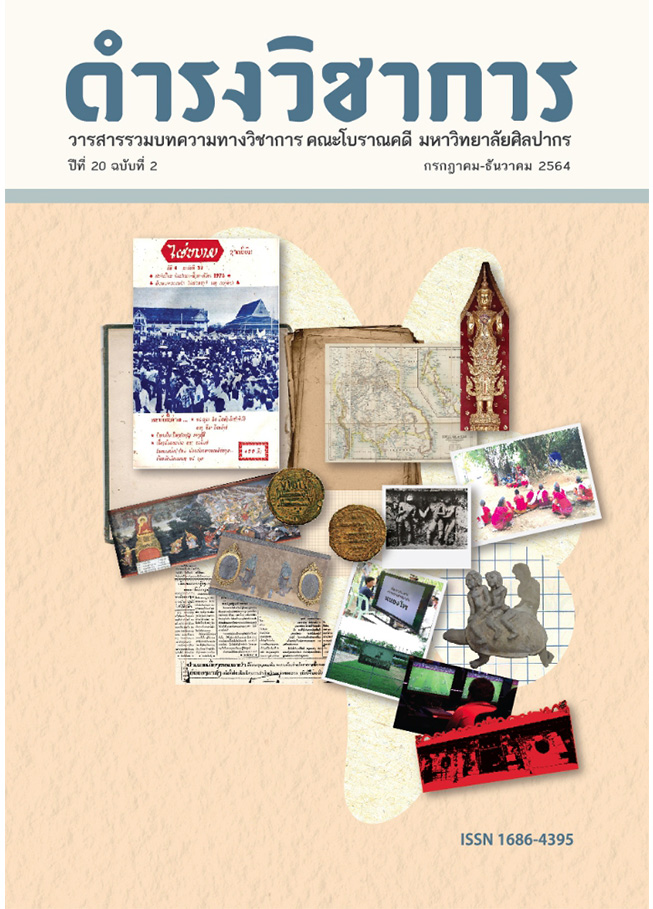Fully-Bejeweled Buddha Images of High-Class Thai Art: Their Art Styles, Meanings and Techniques
Keywords:
Bejeweled Buddha, Royal Caster, Artistic Role Model, Meaning and TechniquesAbstract
This research article aims to study the art and process of casting the Buddha image, which is a valuable national cultural heritage and an example of high-class craftsmanship in the Royal Court of Thai craftsmen. This article aims to add to our national knowledge database by preserving, explaining, transmitting and reconstructing the concepts, methods, forms and motifs of creating and casting the Buddha image in Thailand through the academic lens of art history.
The earliest evidence of bejeweled Buddha images in Thailand can be traced back to around the 12th century A.D., which was in the period of Angkor Wat and Haripunchai. Since the 16th century A.D., the images of this group were created according to Jambupati Sutra. The style and concept of bejeweled Buddha in the Lanna Kingdom were spread to central Thailand during the mid to late Ayutthaya period, and were later inherited in the Rattanakosin period.
During the era from the time of King Rama I to that of King Rama III, the bejeweled Buddha images were made according to the Royal Court’s tradition, which was to represent a royal family member. Casting them was considered as a great merit-making activity in dedication to the represented. Their decorations were delicately made by various complicated techniques. However, the concept related to Jambupati Sutra was less popular than in the past
In the reign of King Rama V, there was a big change in casting these images. Casting them became popular outside the court. Some of their styles were derived from the court while some demonstrated new forms of creativity. The latter can be seen from the usage of soapstone molds, new decorative patterns, new working methods, and inclusion of some metal elements; these features made casting bejeweled Buddha images easier. The group of casters was in Ban Chang Lor of nowadays Thonburi district. This popularity spread to other areas in central Thailand and ended in the period of WWII because of two factors, namely the lack of casters and the occurrence of new easier and cheaper casting techniques employed in casting factories.
This research also records the whole original ancient casting process which is still employed by the remaining casters of Ban Chang Lor, including forming sculptures and producing decorative patterns from soapstone molds. Thus, this helps us to conserve the wisdom of Thai ancient master artisans to some extent.
References
ภาษาไทย
ถนอม บรรณประเสริฐ และ รัชดา โชติพานิช, 2563. พระประวัติ พระวรวงศ์เธอ พระองค์เจ้าประดิฐวรการ แม่กองสร้างวัดราชบพิธสถิตมหาสีมาราม พุทธศักราช 2412-2428. กรุงเทพฯ: วัดราชบพิธสถิตมหาสีมาราม.
ธนภัทร์ ลิ้มหัสนัยกุล, 2558. “ชมพูบดีสูตรในจิตรกรรมฝาผนังช่วงพุทธศตวรรษที่ 24 – 25.” วิทยานิพนธ์ปริญญาศิลปศาสตรมหาบัณฑิต สาขาวิชาประวัติศาสตร์ศิลปะ บัณฑิตวิทยาลัย มหาวิทยาลัยศิลปากร.
“พระราชพงศาวดารกรุงเก่าฉบับหลวงประเสริฐ.” 2542. ใน วีณา โรจนราธา และคณะ (บรรณาธิการ), ประชุมพงศาวดารฉบับกาญจนาภิเษก เล่ม 1 (หน้า 207-234). กรุงเทพฯ: กองวรรณกรรมและประวัติศาสตร์ กรมศิลปากร.
ศรีศักร วัลลิโภดม, 2553. กรุงศรีอยุธยาของเรา. กรุงเทพฯ: มติชน.
ศักดิ์ชัย สายสิงห์, 2556ก. ศิลปะล้านนา. กรุงเทพฯ: มติชน.
____________, 2556ข. พระพุทธรูปในประเทศไทย: รูปแบบ พัฒนาการ และความเชื่อของคนไทย. กรุงเทพฯ: ภาควิชาประวัติศาสตร์ศิลปะ คณะโบราณคดี มหาวิทยาลัยศิลปากร.
สมมตอมรพันธุ์, พระเจ้าบรมวงศ์เธอ กรมพระ, 2508. “ประกาศสมภาคาภิเศก เท่ารัชกาลที่ 4.” ใน ประกาศการพระราชพิธี เล่ม 2 สำหรับพระราชพิธีการจร (หน้า 242-252). พระนคร: องค์การค้าของคุรุสภา.
สันติ เล็กสุขุม, 2560. ศิลปะอยุธยา: งานช่างหลวงแห่งแผ่นดิน. นนทบุรี: เมืองโบราณ.
สุริยวุฒิ สุขสวัสดิ์, ม.ร.ว., 2535. พระพุทธปฏิมาในพระบรมมหาราชวัง. กรุงเทพฯ: สำนักราชเลขาธิการ, จัดพิมพ์เนื่องในวโรกาสเฉลิมพระชนมพรรษา 5 รอบ สมเด็จพระนางเจ้าสิริกิติ์ พระบรมราชินีนาถ วันที่ 12 สิงหาคม พุทธศักราช 2535.
สัมภาษณ์
สุรพันธุ์ อติชาตนันท์, 2563. ช่างหล่อพระ และเจ้าของโรงหล่อพัฒนช่าง. สัมภาษณ์, 2 พฤศจิกายน.
จดหมายเหตุ
“ว่าด้วยพระพุทธปฏิมากรฉลองพระองค์.” ม.ป.ป. อักษรไทย. ภาษาไทย. เส้นดินสอ. เลขที่ 187. ตู้ 121. ชั้น 3/1. มัดที่ 4. หอสมุดแห่งชาติ.
“หนังสือกราบบังคมทูล รัชกาลที่ 5.”, 2426. อักษรไทย. ภาษาไทย. ตัวพิมพ์. เลขที่ ม.ร.5 นก/25.19. หอจดหมายเหตุแห่งชาติ.
ภาษาต่างประเทศ
Griswold A.B., 1963. “Notes on the art of Siam, no.6. Prince Yudhisthira.” Artibus Asiae 26 (3): 215-229.
Twist R.L., 2018. “Images of the crowned Buddha along the Silk Road: Iconography and ideology.” Humanities 7 (4): 1-31.
Downloads
Published
Issue
Section
License
บทความนี้เป็นผลงานของข้าพเจ้าแต่เพียงผู้เดียว และ/หรือเป็นผลงานของข้าพเจ้าและผู้ร่วมงาน ตามชื่อที่ระบุในบทความจริง และเป็นผลงานที่มิได้ถูกนำเสนอหรือตีพิมพ์ที่ใดมาก่อน


